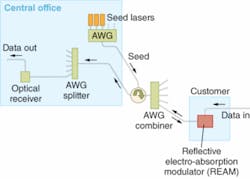FIBER-OPTIC NETWORKS: R-EAM allows simple 10 Gbit/s uplinks

The first commercial reflective electro-absorption modulator (R-EAM) has been released by CIP Technologies (Ipswich, England). The device provides a simple and inexpensive way of extending two-way high-speed optical-fiber networks to the consumer world, allowing customers to uplink at speeds to 10 Gbit/s (see figure). The reason for the simplicity is that all laser light sources, even for customer uplinking, are contained back at the central facility.
The absorption of the R-EAM changes with applied electric field, a result of the quantum-confined Stark effect acting within the multi-quantum-well structure. The rear facet of the indium phosphide chip has a high-reflectivity coating to return the incoming laser light along the same path back to the input fiber. “Think of it operating as a shutter in front of a mirror,” says David Smith, chief technical officer at CIP. The very short (less than 1 mm) optical path within the device reduces bandwidth-limiting signal distortion.
The R-EAM can generate useful modulation over a 32 nm band centered on the 1550 nm C-band. A complete network consists of many “seed” lasers at the central facility, each with a slightly different wavelength, with an arrayed waveguide grating (AWG) combining their light to be sent long-distance over a single fiber. In the customers’ neighborhood, an AWG splitter/combiner sends each wavelength to and from a different customer, and then back over the single fiber. At the central facility, and AWG splitter and optical receivers collect the signals from the customers.
A second major application for R-EAMs is in wireless networks, where the devices make it possible to extend the coverage of a wireless access point with a network of remote antennas. For example, a single fiber-optic cable could easily support 32 antennas operating on different wavelengths, providing a low-cost means of extending the coverage of short-range, high-data-rate wireless technologies around a building or plant. Because of the passive way in which R-EAMs operate, the cost of remote nodes in this application could be extremely small, as in their simplest form they can be fabricated with just a R-EAM and a simple antenna and operate without any need for local power. Because the R-EAM will also operate as a photodiode, these passive nodes can provide both uplink and downlink capabilities.
Smith notes that CIP Technologies plans to extend the modulation bandwidth of its R-EAMs to 40 Gbit/s and beyond. Such data rates are to today’s high-speed internet-uplink rates as today’s rates are to old-time dial-up modem rates; while these days we easily send videos to one another online, at 40 Gbit/s we’ll likely be communicating in ways as yet unimagined.
About the Author
John Wallace
Senior Technical Editor (1998-2022)
John Wallace was with Laser Focus World for nearly 25 years, retiring in late June 2022. He obtained a bachelor's degree in mechanical engineering and physics at Rutgers University and a master's in optical engineering at the University of Rochester. Before becoming an editor, John worked as an engineer at RCA, Exxon, Eastman Kodak, and GCA Corporation.
